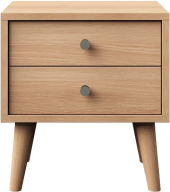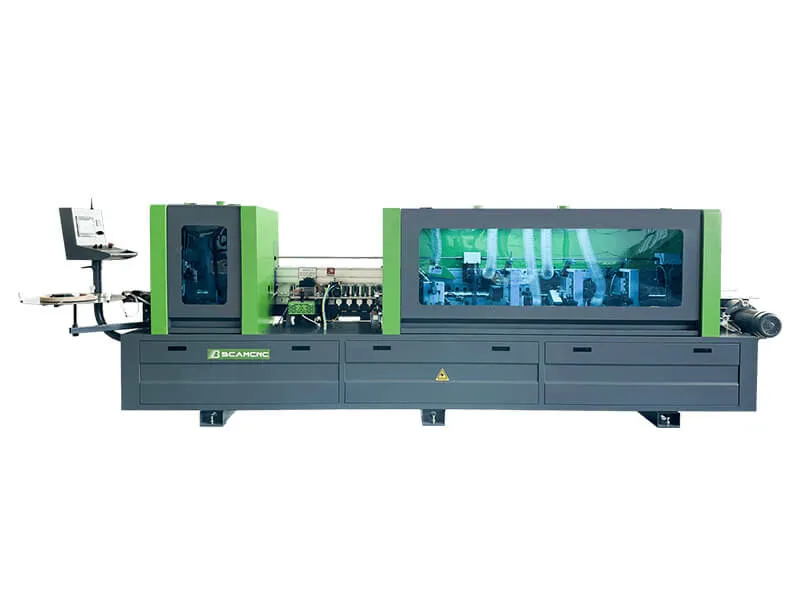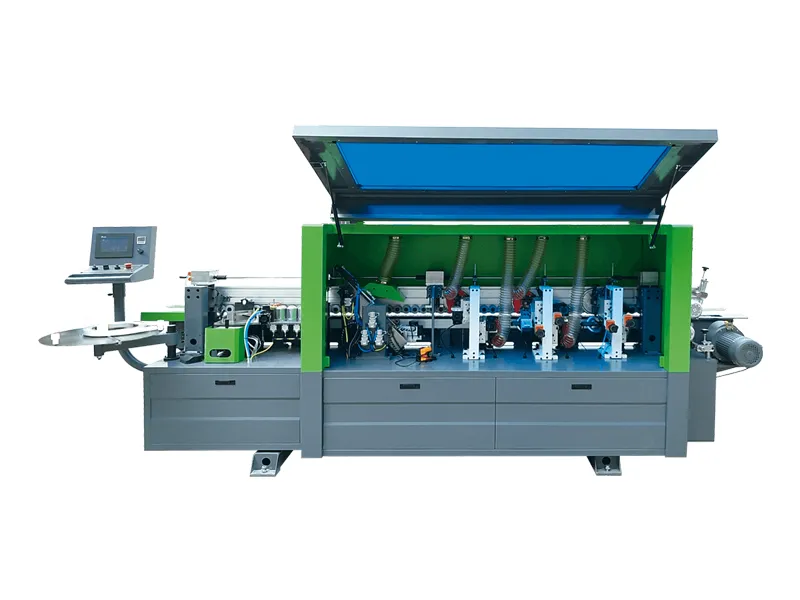Monday To Saturday
8:30 AM - 6:00 PM
High-Quality Normal Speed Edge Banding Machines for Furniture & Cabinet
Normal Speed Edge Banding Machine for Woodworking & Furniture Manufacturing
Normal speed edge banding machines are the most popular and cost-effective solution for small and medium-sized woodworking factories, distributors, and dealers. Designed for MDF, plywood, particle board, solid wood, and composite panels, these machines ensure smooth, durable, and professional edges for furniture and cabinet production.
Our normal speed edge banding machines include semi-automatic models, single-side, double-side, and advanced configurations with pre-milling and tracking functions. Equipped with reliable PLC control systems, aluminum alloy or steel beam structures, and high-performance motors, they provide stable operation and long service life.
Whether you are producing cabinets, wardrobes, office furniture, wooden doors, or decorative panels, a normal speed edge banding machine can help improve efficiency, reduce labor costs, and deliver high-quality finished products.
Browse our range of models (BCF501, BCF505, BCF506, BCF506P, BCF506C, BCF506PC) to find the right edge bander for your woodworking business.
$6,450.00 Original price was: $6,450.00.$6,229.00Current price is: $6,229.00.
$5,420.00 Original price was: $5,420.00.$5,075.00Current price is: $5,075.00.
Explore Reliable Normal Speed Edge Banding Machines
BCAMCNC normal speed edge banding machines deliver reliable performance for woodworking factories, furniture makers, distributors, and dealers. With versatile models including semi-automatic, double-side, pre-milling, and tracking functions, they handle MDF, plywood, particle board, solid wood, and composite panels. Durable PLC control systems and stable structures ensure smooth operation and long service life. Browse BCF501–BCF506PC to find the perfect edge bander for your business.
What Is A Normal Speed Edge Banding Machine?
A Normal Speed Edge Banding Machine is a cost-effective and reliable woodworking machine designed to apply durable edge bands on various types of panels, including MDF, plywood, particle board, solid wood, and composite panels. It is widely used in furniture manufacturing, cabinet production, wardrobe and door fabrication, and decorative panel processing.
These machines are ideal for small and medium-sized woodworking factories, distributors, and dealers who need consistent edge finishing with lower operational costs compared to high-speed or fully automatic models.
Normal speed edge banders can come in multiple configurations, including semi-automatic, single-side, double-side, pre-milling, and tracking functions, offering flexibility to meet different production requirements while ensuring smooth, professional edges on furniture and cabinetry.
How A Normal Speed Edge Banding Machine Works?
A normal speed edge banding machine works by efficiently applying edge tape to wooden panels, ensuring smooth and durable finishes for furniture and cabinet production. The machine follows a standard workflow that includes gluing, trimming, edge scraping, and polishing to create precise, high-quality edges.
Depending on the model, it can be semi-automatic, single-side, double-side, or equipped with pre-milling and tracking functions, allowing for flexibility in different production setups. The PLC or touch-screen control system ensures accurate operation, reduces human error, and makes it easy for operators to adjust settings according to panel thickness and material type.
This process is suitable for various materials such as MDF, plywood, particle board, solid wood, and composite panels, making the normal speed edge banding machine a reliable solution for cabinet makers, furniture manufacturers, and woodworking distributors or dealers.
Features & Advantages of Normal Speed Edge Banding Machines
Our normal speed edge banding machines offer versatile and reliable solutions for furniture edge banding, cabinet production, and woodworking factories, providing high-quality finishes at a cost-effective price. Key features and advantages include:
1. Multiple Functional Configurations
Semi-automatic, single-side, and double-side models for different production needs.
Advanced models equipped with pre-milling and tracking functions to ensure precise edge alignment and smooth finishing.
Core processes include gluing, trimming, edge scraping, and polishing, suitable for MDF, plywood, particle board, solid wood, and composite panels.
2. User-Friendly Operation
Equipped with PLC or touch-screen control systems, allowing easy adjustments for panel thickness and production speed.
Simplifies workflow and reduces human error, improving efficiency for distributors, dealers, and small to medium-sized factories.
3. Durable Structure and Components
High-quality steel or aluminum alloy beam structures for stability and long service life.
Reliable motors and electrical components ensure consistent performance during extended production.
4. Cost-Effective Solution
Designed for small and medium woodworking factories, offering excellent value without compromising performance.
Flexible configurations accommodate different budgets and production scales.
5. Wide Application Range
Ideal for cabinet making, office furniture, wardrobes, wooden doors, and decorative panels.
Supports various materials, making it a versatile choice for a broad range of woodworking projects.
Applications and Suitable Materials for Normal Speed Edge Banding Machines
Our normal speed edge banding machines are designed for a wide range of woodworking applications, making them an ideal choice for furniture manufacturers, cabinet makers, distributors, and dealers.
Suitable Materials:
MDF (Medium-Density Fiberboard) – Perfect for smooth and consistent edge finishing.
Plywood – Ensures durable edges for panels used in cabinets and furniture.
Particle Board – Cost-effective solution for large-scale furniture production.
Solid Wood – Provides high-quality finishes for doors, wardrobes, and custom furniture.
Composite Panels – Handles multi-layer and decorative boards with precision.
Applications:
Cabinet Making – For kitchens, wardrobes, and office storage units.
Furniture Production – Ideal for tables, chairs, desks, and other wood furniture.
Doors and Wardrobes – Delivers smooth, durable edges on solid and composite wood doors.
Decorative Panels and Wood Surfaces – Perfect for wooden wall panels, moldings, and crafts.
With these capabilities, normal speed edge banding machines provide efficient, high-quality edge finishing for a variety of woodworking projects, helping factories and dealers improve productivity while maintaining professional results.
Types of Normal Speed Edge Banding Machines
Normal speed edge banding machines are available in several functional types to meet different woodworking needs:
1. Semi-Automatic Edge Banders
Basic machines for edge gluing and trimming.
Suitable for small workshops and low-volume production.
Easy to operate and cost-effective.
2. Single-Side Edge Banders
Trims and finishes one side of the panel.
Ideal for furniture, cabinets, and office panels.
Compact and stable, perfect for small to medium production lines.
3. Double-Side Edge Banders
Trims both sides of the panel simultaneously for professional finishes.
Efficient for higher production volumes.
Ensures uniform and smooth edges on larger panels.
4. Edge Banders with Pre-Milling
Pre-mills the panel edge to remove rough surfaces before banding.
Improves adhesion and edge smoothness.
Suitable for high-quality furniture production.
5. Edge Banders with Tracking
Automatically tracks curved or uneven panels.
Reduces manual adjustment and ensures precise edge alignment.
Ideal for decorative panels and custom furniture.
6. Edge Banders with Pre-Milling & Tracking
Combines both pre-milling and tracking functions for maximum precision.
Delivers professional results with minimal manual intervention.
Suitable for MDF, plywood, particle board, solid wood, and composite panels.
These types of normal speed edge banding machines offer flexible configurations, reliable performance, and smooth edge finishes, making them a versatile solution for cabinet makers, furniture manufacturers, and woodworking distributors or dealers.
Costs and Pricing Reference for Normal Speed Edge Banding Machines
Normal speed edge banding machines offer a cost-effective solution for small and medium-sized woodworking factories, furniture manufacturers, cabinet makers, distributors, and dealers. Prices vary depending on functionality, automation level, and structural configuration.
• Semi-Automatic and Single-Side Machines – Budget-friendly options suitable for small workshops and low-volume production.
• Double-Side Machines – Mid-range pricing for medium to high-volume production lines, delivering efficient and consistent edge finishes.
• Machines with Pre-Milling or Tracking Functions – Higher investment for advanced features, ideal for high-quality furniture production and professional cabinetry.
Investing in the right machine helps improve production efficiency, reduce labor costs, and achieve smooth, durable edges on MDF, plywood, particle board, solid wood, and composite panels. For exact pricing and the best model for your needs, contact our distributors or dealers to receive a tailored quotation.
Buyer’s Guide for Normal Speed Edge Banding Machines
A normal speed edge banding machine is a precision woodworking tool with automatic electrical control and programmed operation. When selecting a machine, careful review is essential to ensure it meets your production needs.
1. Understanding
Review the manufacturer’s product introduction, specifications, and performance.
Learn about the scope of use, operation method, functional features (semi-automatic, single/double side, pre-milling, tracking), price range, and after-sales support.
This step helps you gain a general understanding of which machine type suits your furniture or cabinet production.
2. Inspection
Check the machine’s appearance and ensure all parts are complete.
Watch demonstration videos, observe the edge bonding effect, and understand operational essentials.
Verify that the machine supports the panel types you work with: MDF, plywood, particle board, solid wood, and composite panels.
3. Testing
Conduct a test run to check power supply, air supply, and mechanical smoothness.
Listen for unusual noises and verify that functions like pre-milling or tracking operate correctly.
Based on this, decide if the machine meets your production requirements for efficiency, edge quality, and operational reliability.
By following these steps, distributors, dealers, and woodworking factories can confidently select the right normal speed edge banding machine to improve productivity, reduce labor costs, and achieve professional edge finishes.
How To Use A Normal Speed Edge Banding Machine?
Using a normal speed edge banding machine correctly ensures smooth, durable edges and extends the machine’s service life. Whether you are a novice or experienced operator, following proper steps is essential for efficiency and quality.
Preparation
• Install the machine on a stable surface and connect the correct power and air supply.
• Ensure all components, such as glue pots, trimming knives, and rollers, are clean and in good condition.
• Select the appropriate edge banding tape for your panel (MDF, plywood, particle board, solid wood, or composite panels).
Machine Setup
• Adjust thickness and width settings according to the panel dimensions.
• Configure the machine functions: semi-automatic, single-side or double-side trimming, pre-milling, and tracking.
• Verify the PLC or touch-screen control settings for your production run.
Step-by-Step Operation (Quick Guide)
1. Select the Edge Banding Tape – Match the tape color and type to your panel.
2. Load the Tape – Place it on the feeder or turntable and guide it into the machine.
3. Prepare the Panel – Place it on the working table, aligned with guide rails.
4. Feed the Panel – Slowly push the panel into the machine while keeping it pressed against the guide.
5. Automatic Edge Banding – Conveyor rollers carry the panel through the machine. Glue is applied, edges are trimmed, and surfaces polished.
6. Trim Excess Tape – The machine cuts off extra tape and completes the edge sealing process.
7. Collect the Panel – Remove the finished panel at the output section and inspect the edge.
8. Repeat for Next Panel – Prepare and feed the next panel following the same steps.
Post-Operation & Maintenance Tips
• Turn off the machine and clean glue residues, trimming parts, and rollers.
• Inspect the finished edges to ensure quality.
• Perform routine maintenance to prolong the machine’s service life.
Using this approach, normal speed edge banding machines help improve production efficiency, reduce labor costs, and achieve professional edge quality for furniture, cabinets, doors, wardrobes, and decorative panels.
Care & Maintenance for Normal Speed Edge Banding Machines
Proper care and maintenance of your normal speed edge banding machine is essential to prevent failures, prolong machine life, reduce maintenance costs, and improve work efficiency. Follow these tips to keep your machine in optimal condition:
1. Regular Lubrication
Apply appropriate lubricating oil to the bearings and moving parts.
Using the correct oil ensures smooth operation and prevents premature wear.
2. Periodic Inspection
Check for wear on gears, bearings, and other critical parts.
Tighten loose screws and replace worn components promptly.
Inspect electrical circuits regularly to prevent operational issues.
3. Timely Cleaning
Remove waste and debris generated during operation to prevent machine jams.
Clean surface stains to maintain a neat appearance and avoid corrosion.
4. Keep the Operating Area Clear
Remove scrap material around the machine to ensure safe and efficient operation.
5. Adjust Glue Application
Set the glue amount and temperature according to the panel thickness, width, and size, as well as the machine’s heating capacity.
Proper glue settings ensure strong adhesion and a smooth edge finish.
6. Clean the Glue Pot Regularly
Prevent carbon deposits caused by long-term high-temperature heating.
This maintains consistent heating and ensures proper glue flow.
7. Clean the Glue Return Port
Keep the back glue port unblocked to prevent contamination of the panel edges.
Prevent glue buildup on the conveyor belt and travel switch, which can cause malfunctions.
8. Maintain Proper Workshop Temperature
Avoid extreme temperatures during operation.
Too low can freeze oil and hinder operation; too high can cause heat dissipation problems and motor damage.
Following these care and maintenance tips helps your normal speed edge banding machine deliver consistent performance, extend its service life, and maintain high-quality edge banding for furniture, cabinets, doors, wardrobes, and decorative panels.
Repair & Troubleshooting for Normal Speed Edge Banding Machines
Even a reliable normal speed edge banding machine may encounter faults during long-term use. Understanding common issues and their solutions can reduce downtime and maintain high-quality edge banding.
1. Pressing Issues
Fault: Panel is not pressed tightly, or front and rear pressing heights are uneven, causing deviation during trimming and polishing.
Solution: Ensure the panel is firmly pressed, align the reference ruler and profiling wheel with the panel, and adjust the tool until proper trimming is achieved.
2. Trimming Reference Problems
Fault: Trimming knife cannot find the panel surface, resulting in inaccurate edge cutting.
Solution: Feed a long, flat-ended panel (without glue), stop the conveyor at the working position, align horizontal and vertical reference parts with the panel, and fine-tune the tool.
3. Loose Screws
Fault: Unstable trimming due to loose screws.
Solution: Tighten screws at benchmark positions and adjust the tool. Polishing issues will resolve once trimming is correct.
4. Rear Head Descending Too Fast
Fault: Excessive downward speed or air pressure causes collision with the panel.
Solution: Adjust the inlet/exhaust pressure regulating valve of the rear cylinder to reduce speed and force.
5. Front Head Pressure Too High
Fault: Board collides with front head when advancing.
Solution: Adjust the front pressure regulating valve for softer operation.
6. Travel Switch Faults
Fault: Incorrect or broken travel switch prevents the front head from descending.
Solution: Reposition or replace the travel switch.
7. Guide Wheel Issues
Fault: Missing or damaged guide wheels cause panel cracking.
Solution: Install new guide wheels.
8. Burrs on Headrest Ruler
Fault: Burrs interfere with panel contact.
Solution: Remove burrs with fine gauze.
9. Electrical Faults
Fault: Machine stops, slow heating, or program errors.
Solution: Inspect motor, control box, and delay devices; seek professional or manufacturer support if needed.
10. Pneumatic Circuit Faults
Fault: Air valve failure, leaks, low air pressure, feeding or cutter failure.
Solution: Check all pneumatic components and replace parts under manufacturer guidance.
11. Mechanical Faults
Fault: Transmission failure, uneven glue, feeding or cutter failure.
Solution: Inspect and secure all mechanical components, and verify transmission alignment.
12. Adhesive Faults
Fault: Glue not sticking, deviation, or panel misalignment.
Solution: Check rubber shafts, edge banding tape, glue system, substrate, and operation technique; maintenance depends on the specific situation.
Secure Payments
Tellus gravida ipsum aut facilisis tempus at et aliquam estsem.
Free Shipping
Non pulvinar aenean ultrices lectus vitae imperdiet vulputate a eu.
Gifts & Sales
Aliquet ullamcorper leo mi vel sit pretium euismod eget libero.
24/7 Support
Nullam iaculis vestibulum arcu id urnain pellentesque volutpat quis.

Important updates waiting for you!
Subscribe and grab 20% OFF!


